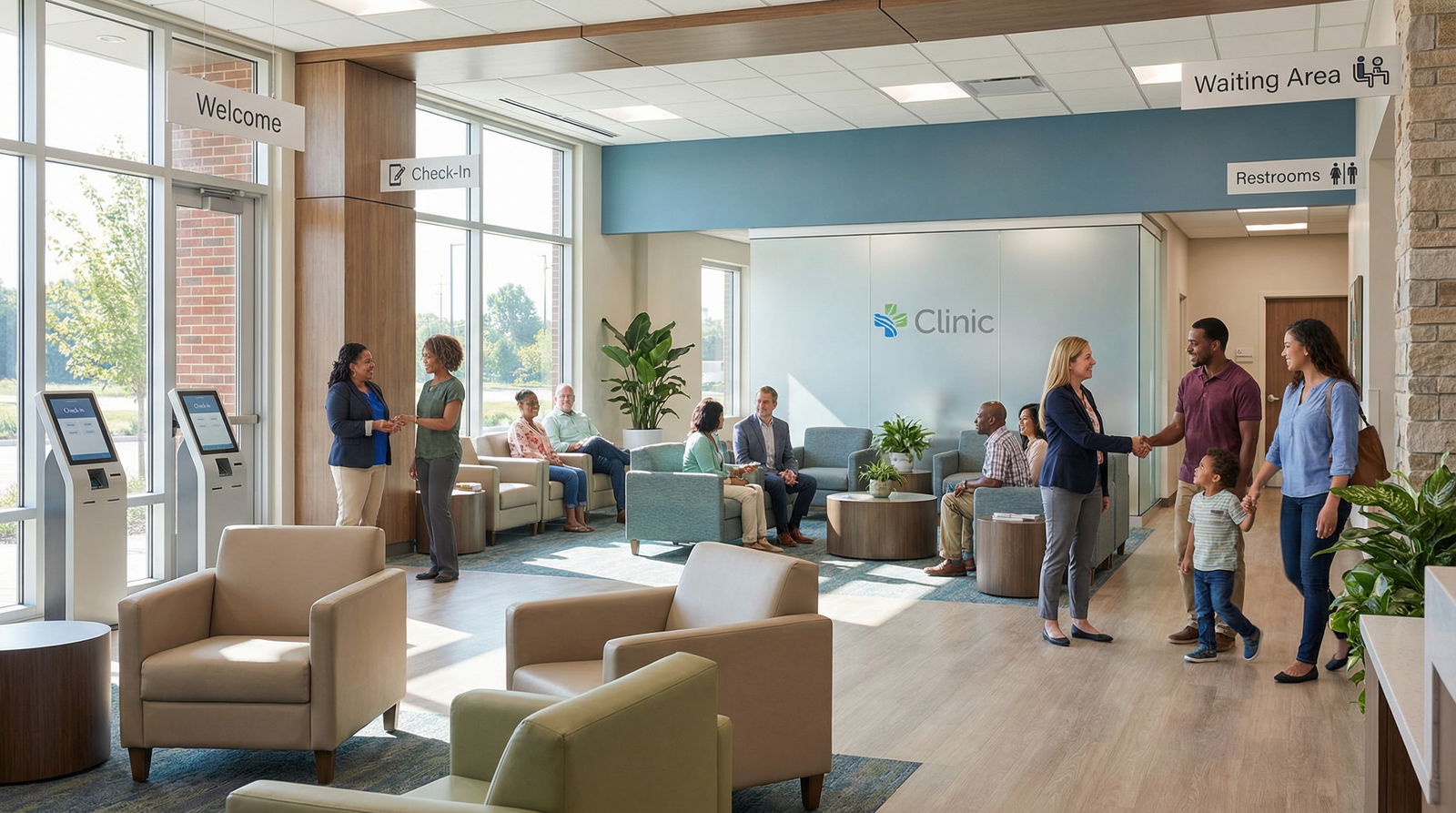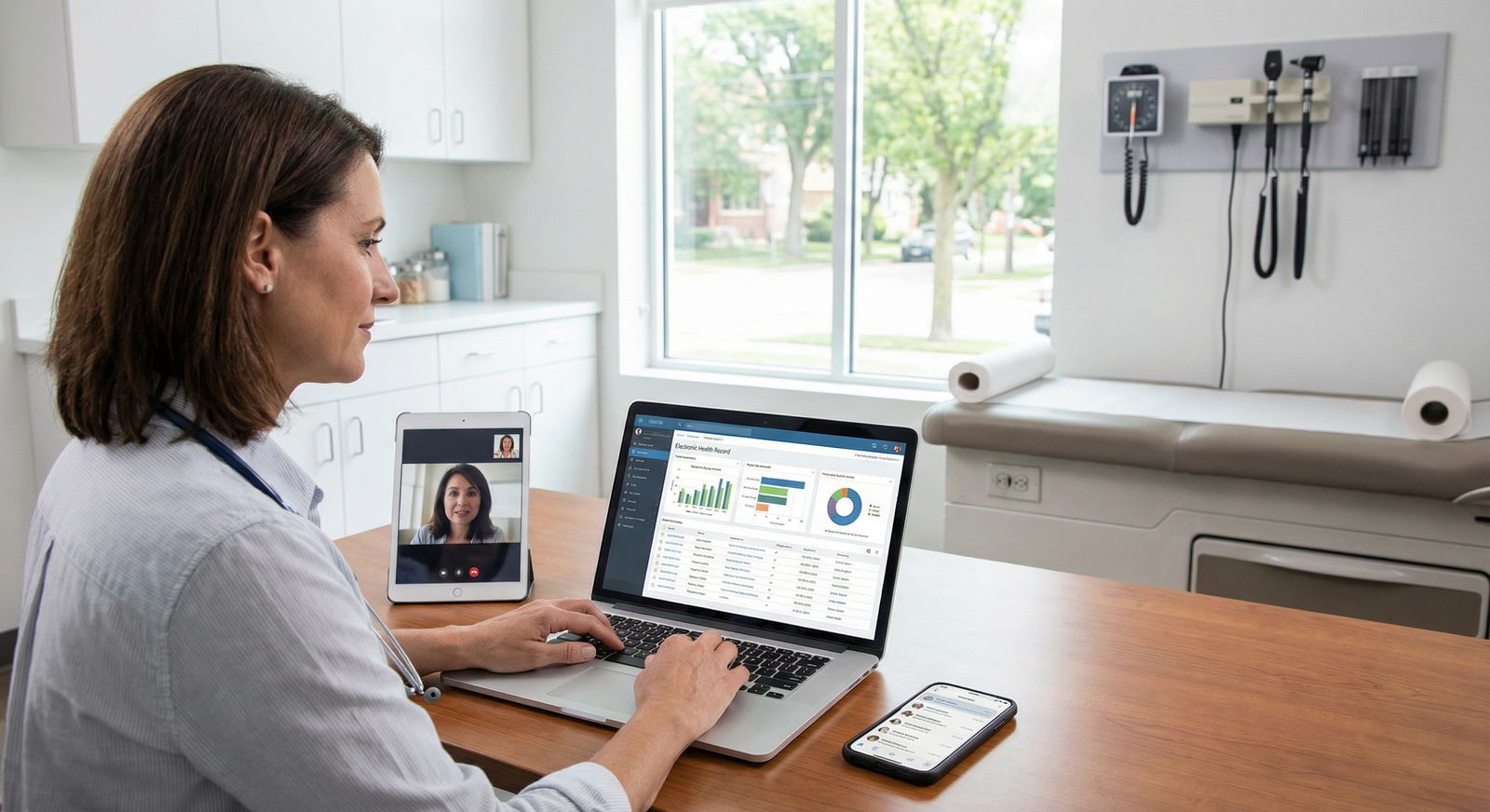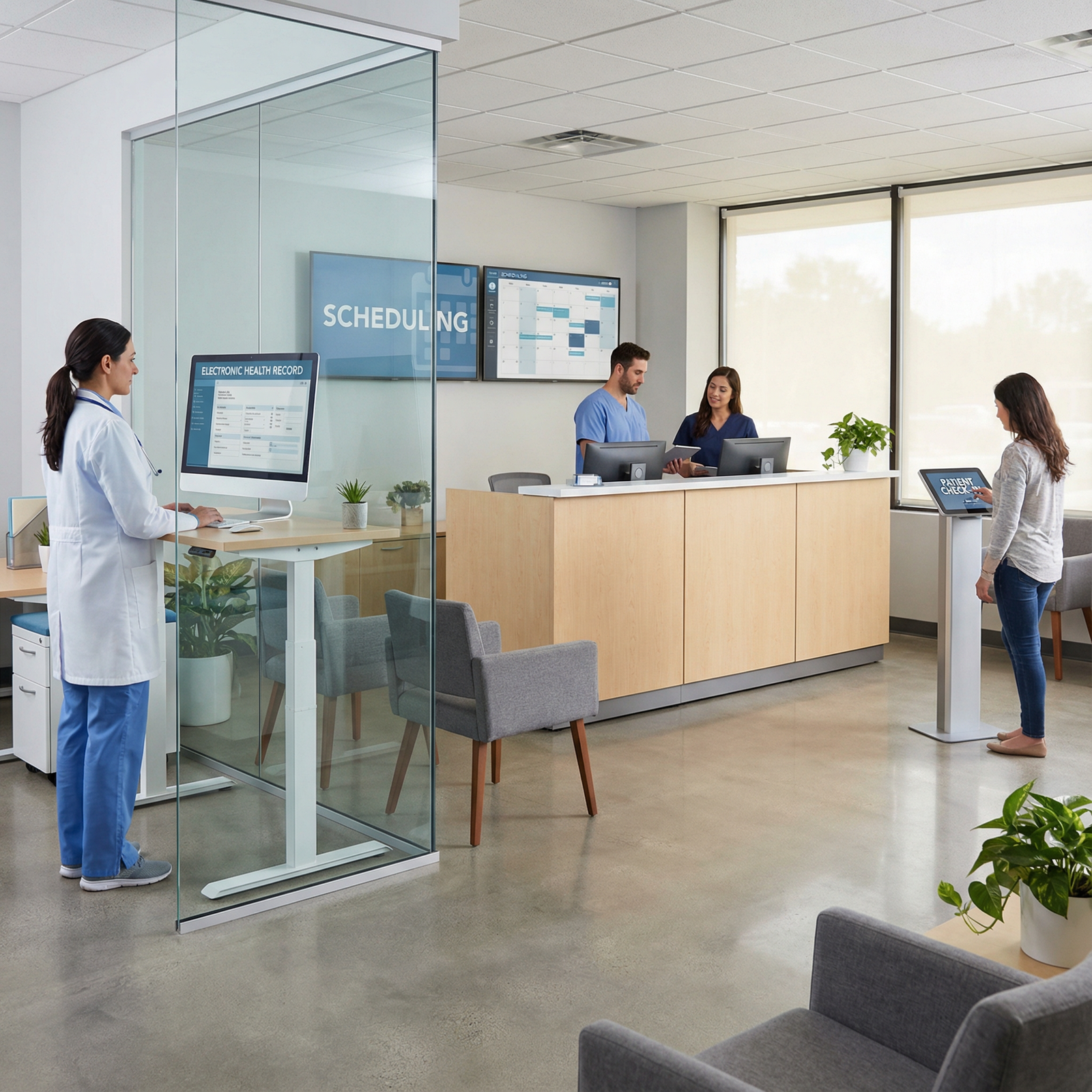Crafting a Patient-Centric Care Model for Your Medical Practice

Transforming your practice from “visit-based” to truly service-centric is one of the most powerful moves you can make after residency. As you transition into independent practice or launch a private clinic, your Patient-Centric Care model will define not just your outcomes, but also your reputation, revenue stability, and long-term sustainability.
In a competitive, value-based healthcare environment, patients have choices—and they increasingly expect the same level of service they receive from banks, airlines, and tech companies. A thoughtfully designed service model can turn your practice into a place where patients feel known, respected, and supported at every touchpoint.
This guide walks through how to design a service-centric practice experience that aligns clinical excellence with exceptional service, using Healthcare Design, workflow optimization, and Healthcare Technology to drive Patient Satisfaction and loyalty.
Understanding Patient-Centric Care Models in Modern Practice
Before you can design a service-centric experience, you need a clear grasp of what Patient-Centric Care really means in the context of a modern outpatient practice or private clinic.
Patient-centered care is more than being “nice” or “thorough.” It is a systematic, intentional way of organizing care so that patient goals, values, and preferences consistently shape clinical decisions, communication, and operations.
Core Principles of Patient-Centered, Service-Centric Care
You can think of patient-centered care as a framework with four interlocking pillars:
Respect and Dignity
- Patients are seen as people first, not diagnoses or time slots.
- Values, cultural background, language preferences, gender identity, and personal priorities are elicited and honored.
- Examples: Asking for preferred name and pronouns, offering chaperones, adjusting explanations to match health literacy.
Information Sharing
- Clinical information is transparent, timely, and understandable.
- Risks, benefits, and alternatives are laid out in plain language.
- Patients have convenient access to their notes, test results, and care plans via portals or printouts.
Participation
- Patients are invited—and explicitly encouraged—to participate in decision-making at the level they choose.
- Shared decision-making tools, decision aids, and teach-back techniques are used routinely.
- Family or caregivers are included with the patient’s permission, especially for serious or chronic conditions.
Collaboration
- Care is coordinated across disciplines (e.g., primary care, behavioral health, specialists, pharmacy).
- The care team, patient, and family act as partners rather than in a top-down hierarchy.
- Systems exist to avoid fragmentation: clear referrals, closed-loop communication, and follow-up.
When translated into your daily operations, these principles drive a care model where service is not an add-on but woven into scheduling, layout, staffing, and technology choices.
Designing a Service-Centric Patient Care Experience: From Concept to Workflow
A “service-centric” practice is intentionally designed across multiple dimensions: communication, access, personalization, environment, and feedback. Below are the major domains you should consider when either starting a private practice or reshaping an existing one.

1. Building Excellent Communication into Your Service Model
Communication is often the single biggest driver of Patient Satisfaction—and also the most common source of complaints.
Strategies to Strengthen Communication
Standardize Opening and Closing Scripts
Teach clinicians and staff to:- Introduce themselves and their role every time.
- Ask, “What is the most important thing you want to address today?”
- Close with, “What questions do you still have?” and a brief summary of the plan.
Leverage Multiple Communication Channels
- Secure messaging via patient portal for non-urgent questions.
- Structured phone triage protocols with trained staff.
- SMS reminders (with consent) for appointments, labs, and follow-ups.
Use Teach-Back Consistently
Ask: “Just so I know I explained it well, can you tell me in your own words what our plan is?”
This identifies misunderstandings before the patient leaves.Communication Training for the Entire Team
- Role-play difficult conversations (e.g., delays, billing confusion, test results).
- Teach de-escalation techniques for frustrated patients.
- Emphasize empathy as a skill, not a personality trait.
Well-designed communication workflows reduce no-shows, improve adherence, and protect your time by preventing unnecessary back-and-forth.
2. Making Care Truly Accessible: Time, Location, and Convenience
Accessibility is a cornerstone of a service-centric practice. You can provide excellent clinical care, but if it’s hard to get in, patients will leave—or never come.
Operational Strategies to Improve Access
Flexible Scheduling Models
- Offer a mix of same-day/next-day appointments and pre-booked slots.
- Reserve a portion of your schedule (e.g., 20–30%) for acute issues.
- Consider early morning, evening, or limited weekend sessions to serve working patients.
Multiple Access Points
- Phone scheduling PLUS online self-scheduling for eligible visit types.
- Asynchronous e-visits or secure messaging visits for straightforward issues.
- Telehealth visits for follow-ups, medication checks, and some chronic care management.
Reducing Wait Times and Visit Friction
- Online pre-registration and digital forms to shorten front-desk processing.
- “Boarding pass” style check-in: patients confirm info at kiosks or tablets.
- Clear policy for notifying patients when clinics are running behind, with options to reschedule.
Addressing Transportation and Mobility Barriers
- Telemedicine as a default option for patients with mobility challenges, rural locations, or caregiving responsibilities.
- Partnerships with rideshare services or local transit vouchers for high-need patients (e.g., oncology, dialysis).
Improved access is not only good service—it’s also a powerful patient retention and growth strategy for your private practice.
3. Personalization: Turning Visits into Relationship-Based Care
Personalization is the difference between a transactional encounter and a relationship-based practice. In Patient-Centric Care, personalization is deliberate and structured, not ad hoc.
Implementing Personalized Care in a Busy Practice
Individualized Care Plans
- Document patient-specific goals (e.g., “walk 30 minutes to play with grandchildren”) in the EHR.
- Use smart phrases or templates to quickly capture preferences and social context.
- Align treatment decisions with those goals, and reference them explicitly in follow-ups.
Risk Stratification and Tailored Follow-Up
- Identify high-risk or high-need patients (e.g., multimorbidity, frequent admissions, complex psychosocial needs).
- Build tighter follow-up loops: shorter intervals, nurse care manager outreach, or digital check-ins.
- Use automated reminders for labs, imaging, and preventive screenings.
Behavioral Health and Social Determinants Integration
- Integrate or closely partner with behavioral health providers.
- Screen for depression, anxiety, substance use, food insecurity, and housing instability.
- Provide warm handoffs whenever possible: a brief introduction to the behavioral health clinician during the same visit.
Cultural and Language Customization
- Offer interpreter services via phone or video for non-English speakers.
- Translate core instructions and educational materials into your community’s common languages.
- Train staff on cultural differences in communication styles and health beliefs.
Personalization builds loyalty. Patients who feel known and understood are far more likely to adhere to plans and to recommend your practice to others.
4. Turning Patient Feedback into a Continuous Improvement Engine
A modern, service-centric practice treats patient feedback as data—not as a personal judgment. When systematically collected and acted upon, feedback becomes your roadmap for strategic improvement.
Building a Robust Feedback System
Surveys and Micro-Feedback
- Post-visit SMS or email surveys with 3–5 targeted questions (wait time, clarity of instructions, friendliness, overall rating).
- Quarterly in-depth satisfaction surveys to track trends over time.
- Include at least one open-ended question: “What is one thing we could do to improve?”
Patient Advisory Councils
- Recruit a small, diverse group of patients to meet quarterly.
- Review new processes (e.g., telehealth rollout, new check-in workflow) before full implementation.
- Compensate them with gift cards or other tokens of appreciation.
Close the Feedback Loop
- Highlight changes made “because you told us” in newsletters, waiting-room posters, or portal messages.
- Example: “You told us parking was confusing. We’ve added clearer signage and reserved spots near the entrance.”
Monitor Online Reputation
- Track reviews on Google, Healthgrades, and other platforms.
- Respond professionally to both positive and negative reviews (without discussing PHI).
- Use patterns in reviews to identify systemic issues (e.g., front-desk tone, phone hold times).
Consistently acting on feedback demonstrates respect and builds trust—key ingredients in Patient-Centric Care.
5. Empowering and Training Your Team for Service Excellence
Your service model is only as strong as the people who deliver it. Investing in staff development is not optional; it is central to sustaining a service-centric practice.
Key Components of High-Performing Teams
Structured Onboarding and Ongoing Training
- Orientation that explicitly covers your practice’s mission, values, and service standards.
- Annual refreshers on communication, privacy, cultural competence, and technology tools.
- Shadowing and mentorship for new hires to learn “how we do things here.”
Empowered Front-Line Decision-Making
- Give staff clear guidelines and authority to:
- Offer an earlier slot to an upset patient.
- Waive or reduce a small fee in specific, predefined circumstances.
- Escalate concerns quickly without bureaucratic barriers.
- Give staff clear guidelines and authority to:
Team-Based Care Models
- Use medical assistants, nurses, and care coordinators to the top of their license.
- Delegation examples:
- Pre-visit planning and medication reconciliation.
- Standing orders for routine labs or vaccinations.
- Post-discharge follow-up calls.
Recognition and Feedback Culture
- Regularly recognize staff who receive positive patient feedback.
- Incorporate service metrics (e.g., phone response time, portal message turnaround) into performance reviews.
- Hold brief daily or weekly huddles to identify bottlenecks and share quick wins.
Satisfied, supported staff are far more likely to deliver the consistent, compassionate service that defines your practice.
6. Harnessing Healthcare Technology to Enhance the Patient Experience
Thoughtful use of Healthcare Technology is a major differentiator for modern practices. Technology should support your Patient-Centric Care model—not complicate it.
High-Impact Digital Tools
Electronic Health Records (EHR) Optimized for Service
- Use templates and order sets to reduce click burden and preserve face-to-face time.
- Configure dashboards that flag overdue preventive care and chronic disease metrics.
- Empower patients to view notes, labs, and instructions via a secure portal.
Telemedicine and Virtual Care
- Offer telehealth for:
- Medication checks.
- Minor acute issues (e.g., simple rashes, refills, URI symptoms when appropriate).
- Behavioral health visits and chronic disease coaching.
- Build clear clinical protocols for when virtual care is safe and appropriate.
- Offer telehealth for:
Patient Engagement Platforms
- Online appointment booking and rescheduling.
- Secure messaging with expected response-time policies.
- Educational content automatically triggered by diagnoses (e.g., new diabetes, hypertension).
Automation and Efficiency
- Automated reminders for appointments, vaccines, and screenings.
- Digital intake and consent forms that feed directly into the EHR.
- Queue management displays (in some settings) to reduce anxiety about wait times.
When carefully implemented, technology becomes a backbone for your Healthcare Design, enabling care that is more responsive, efficient, and patient-friendly.
7. Designing the Physical and Emotional Environment of Care
The physical layout and atmosphere of your clinic are powerful, often underused components of Healthcare Design. Patients form impressions long before they meet you.
Elements of a Welcoming, Service-Oriented Environment
Reception and Waiting Areas
- Clear signage from the entrance to check-in.
- Comfortable, clean seating with options for families and those with mobility devices.
- Visual cues about your values (e.g., posters about respect, diversity, and patient rights).
Privacy and Confidentiality
- Avoid loud clinical conversations at the front desk.
- Use sound-absorbing materials where possible.
- Provide private spaces for sensitive conversations and financial counseling.
Sensory Considerations
- Neutral or calming color schemes; natural light if available.
- Minimize harsh background noise (e.g., loud TVs, overhead pages).
- Provide charging outlets and Wi-Fi for patients who are waiting.
First Impressions at the Front Desk
- Train staff to greet each patient within seconds of arrival, even if only to say, “I’ll be right with you.”
- Eye contact, use of names, and thanking patients for waiting can transform their experience.
Every touchpoint—from parking to checkout—either reinforces or undermines your service-centric practice vision.
8. Establishing a Culture of Continuous Improvement
Healthcare—and patient expectations—change quickly. A strong service model is never “finished.”
Operationalizing Continuous Improvement
Define and Track Key Metrics
- Clinical: HbA1c control rates, blood pressure control, immunization rates.
- Service: wait times, no-show rates, call abandonment, patient satisfaction scores.
- Operational: panel size, visit length, staff turnover.
Benchmarking and Comparison
- Compare your metrics against national benchmarks or local peers.
- Participate in quality collaboratives or payor quality programs where available.
Plan–Do–Study–Act (PDSA) Cycles
- Implement small tests of change instead of massive overhauls.
- Example:
- Plan: Reduce average phone hold time from 5 minutes to under 2 minutes.
- Do: Add one part-time phone staff during peak hours.
- Study: Measure hold times for 2–4 weeks.
- Act: Adjust staffing or call-routing protocol based on results.
Stay Current on Policy and Technology
- Monitor payer requirements, telehealth regulation changes, and quality incentives.
- Attend CME or workshops on Healthcare Technology and practice management.
A mindset of iterative improvement allows your practice to adapt without burning out your team.
Case Study: HealthPlus Family Practice’s Transition to a Patient-Centric Service Model
To see these principles in action, consider HealthPlus Family Practice, a mid-sized clinic that decided to redesign its operations around Patient-Centric Care.
Starting Point: Fragmented Care and Low Satisfaction
HealthPlus faced:
- Long, unpredictable wait times.
- Inconsistent provider-patient communication.
- Low patient satisfaction scores and increasing negative online reviews.
- Staff burnout and high turnover.
The partners realized that clinical quality alone was not enough; their service model needed a fundamental redesign.
Key Interventions in the Transformation
Comprehensive Staff Training
- All staff underwent workshops on empathy, communication, and de-escalation.
- New scripts for greeting, rooming, and closing visits were implemented.
- A clear escalation path for handling patient concerns was established.
Technology and Workflow Upgrades
- Migrated to a more user-friendly EHR integrated with a robust patient portal.
- Introduced online scheduling and digital check-in.
- Launched telemedicine visits three afternoons per week.
Redesigning Access and Scheduling
- Implemented open-access scheduling with reserved same-day slots.
- Reduced visit types and standardized visit lengths to simplify templates.
- Implemented pre-visit planning for complex patients.
Structured Feedback and Continuous Improvement
- Deployed SMS-based post-visit surveys.
- Formed a patient advisory council that met quarterly.
- Used PDSA cycles to reduce phone wait times and improve lab result communication.
Outcomes After 12–18 Months
- Patient satisfaction scores improved dramatically, especially in communication, wait times, and overall experience.
- Online ratings rose, and word-of-mouth referrals increased new patient volume.
- Staff turnover decreased, and team morale improved.
- Chronic disease quality metrics (e.g., BP control, HbA1c monitoring) also improved, supporting value-based contracts.
The HealthPlus story illustrates that Patient-Centric Care and service excellence are not “extras”—they are integral to clinical outcomes, financial health, and professional fulfillment.

FAQ: Building and Sustaining a Service-Centric Patient Care Model
1. What is the difference between patient-centered care and a service-centric practice?
Patient-centered care is a philosophy that places the patient’s needs, values, and preferences at the center of clinical decision-making.
A service-centric practice is the operational expression of that philosophy—how you design scheduling, communication, physical space, staff roles, and Healthcare Technology to consistently deliver that experience.
In short: patient-centered care is the “why”; a service-centric practice is the “how.”
2. How can I start implementing a service-centric model if my practice is already very busy?
Begin with small, high-yield changes:
- Standardize how you open and close visits.
- Implement simple SMS or email appointment reminders.
- Start a brief daily huddle to identify bottlenecks.
- Introduce a short, post-visit survey to collect feedback.
Once these are stable, you can tackle more complex changes such as telehealth expansion, EHR optimization, or redesigning your scheduling templates.
3. How does healthcare technology really impact patient satisfaction?
When thoughtfully implemented, Healthcare Technology improves Patient Satisfaction by:
- Reducing perceived and actual wait times (online check-in, clear communication).
- Increasing transparency (portal access to results and notes).
- Enhancing convenience (telemedicine, online scheduling).
- Supporting better follow-up and fewer missed results (automated reminders, task management).
Problems arise when technology is poorly integrated, hard to use, or increases clinician burnout. The key is choosing tools that support your workflows rather than dictate them.
4. What metrics should I track to know if my service-centric model is working?
A balanced set of metrics includes:
- Patient experience: satisfaction scores, net promoter score (NPS), online reviews.
- Access: third next available appointment, no-show rate, call abandonment rate.
- Operational: average visit length, documentation time outside clinic hours, staff turnover.
- Clinical quality: chronic disease control (e.g., A1c, BP), preventive care completion.
Review these data regularly (e.g., monthly or quarterly) and connect them to concrete improvement projects.
5. Is a service-centric, patient-centered model financially sustainable for a private practice?
Yes—when strategically executed, it is often more sustainable. High Patient Satisfaction and loyalty drive:
- Better retention and word-of-mouth referrals.
- Stronger performance in value-based contracts and quality incentive programs.
- Lower no-show rates and more efficient schedules.
- Reduced staff turnover and recruitment costs.
While there may be upfront investments (training, technology, design changes), the medium- and long-term returns in revenue stability, efficiency, and professional satisfaction are substantial.
By systematically designing your Healthcare Design, workflows, staffing, and Healthcare Technology around Patient-Centric Care, you create a service model that benefits everyone—patients, staff, and you as a clinician-owner. This is the foundation of a thriving, future-ready private practice in the post-residency landscape.

SmartPick - Residency Selection Made Smarter
Take the guesswork out of residency applications with data-driven precision.
Finding the right residency programs is challenging, but SmartPick makes it effortless. Our AI-driven algorithm analyzes your profile, scores, and preferences to curate the best programs for you. No more wasted applications—get a personalized, optimized list that maximizes your chances of matching. Make every choice count with SmartPick!
* 100% free to try. No credit card or account creation required.












